|
Bowdoin college alumnus Artine Artinian (1907–2005) was a leading scholar of the 19th century French author Guy de Maupassant as well as a collector of drawings, caricatures, and book illustrations from France’s Belle ├ēpoque. In his lifetime Artinian amassed a treasure trove of 19th and early 20th century drawings, many of which he has donated to the Bowdoin College Museum. The present exhibition focuses on works which speak to the intersection of literature and the visual arts in late 19th century France: book illustrations, literary portraits (some of which Artinian commissioned), caricatures and social commentary.
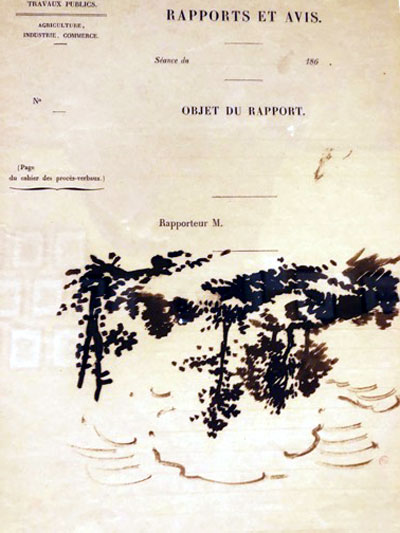
The exhibition begins with a series of psychologically astute portraits and nature studies executed by French authors. There is the boldly hatched, intense-eyed study of a man’s head by Prosper Merim├®e (1803-1870), the author of Carmen who was also an archaeologist with a penchant for nature. This interest is represented by a bold pen and ink study of a forest, the gnarled trees leaping from the sepia paper. And the group is completed by a finely observed drawing of a majestic elk. This last sketch pairs nicely with Alexandre Dumas Fils’ (1824-1895) - the novelist famed for La Dame aux Camelias -Taureau, a pen and ink study of a well-muscled, regal bull.
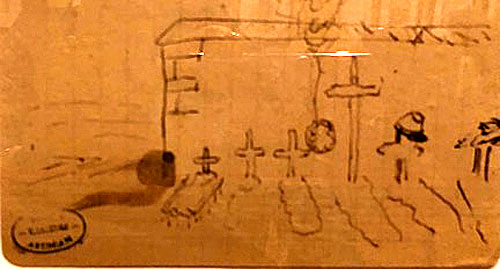
Eerily atmospheric is poet and playwright Guillaume Apollinaire’s (1880-1918) shadowy drawing of a graveyard, the plain wooden crosses in solemn rows, which recalls his own grim experience as a soldier in World War I. Novelist Victor Hugo (1802-1885) apparently had time to turn his hand to drawing during his political exile in 1866, and the great novelist is represented here by a portrait of the Reverend Jacqueman H├®rode. The face is articulated in strong, heavy line, and the eyes seem to burn with an undefined flame - both compelling and frightening. Tiny as this little drawing is, it gives a glimpse of Hugo insight into character, a trait which marks all his novels.
Two other larger self-portraits stand out for their use of light and the detail of their physical observation and the sense of their being infused with an inner presence.
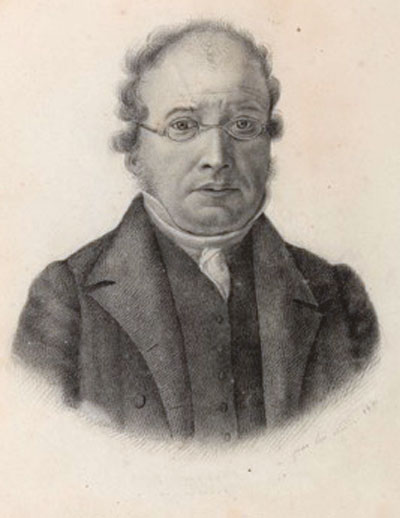
Painter and noted lithographer, Louis Leopold Boilly’s (1761-1845) image of himself depicts a sedately dressed gentleman who wears a concerned, sensitive that is both puzzling and intriguing to the viewer.
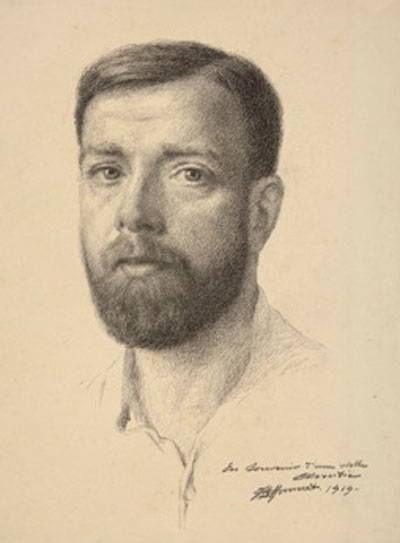
Painter Mimeret’s red chalk self-portrait is riveting in its gaze, the eyes piercing, yet gentle, the face instilled with a calm self-possession.
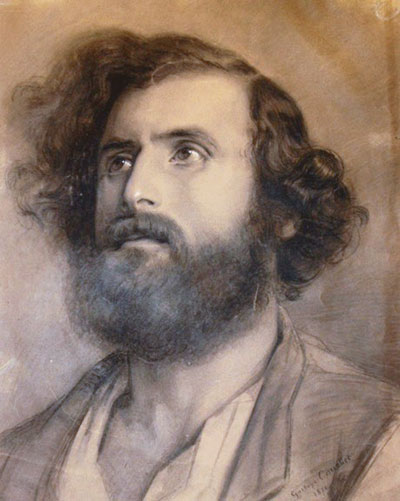
A handsome graphite drawing of an unidentified man by the romantic-realist painter Gustav Courbet (1819-1877) dominates the group. The sitter is wild-haired and open-collared; his eyes gleam with some inner vision and his glance is directed afar and upward. The light glances off his cheekbones and sparkles in his pupils; his lips are slightly parted which makes him seem caught in the very act of breathing; there is a nobility and sensuality all at once.
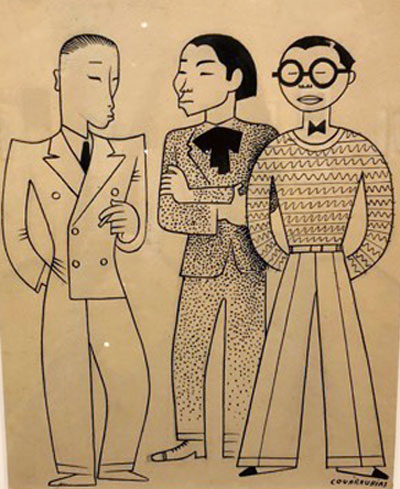
The Romantic aura of the Courbet is in strong contrast to the next group of pen and ink illustrations from Marc Chadourne’s book, Chine, by Mexican artist Miguel Covarrubas (1905-1957). Covarrubas’ work has a two-dimensional, highly linear, print-like quality. Geometric shapes and patterns prevail in Great Wall, while the sketch of Two Women turns the figures into decorative and angular shapes. His Dictator has a menacing air, as the rigid martial figure strides the fine line between portrait and caricature.
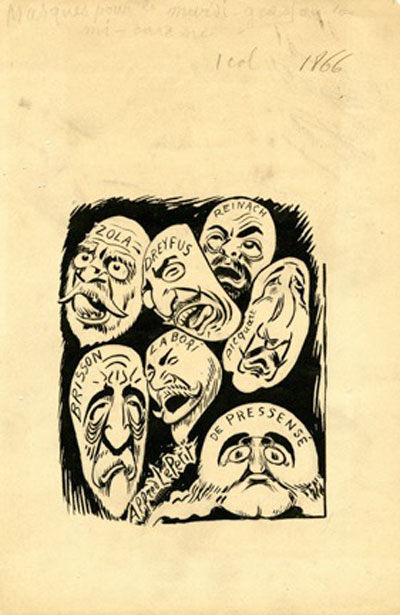
This last drawing makes an admirable transition into the part of the exhibition devoted entirely to political satire and caricature. A group of pen and ink drawings by Alfred Le Petit (1841-1909) from the magazine Le Charivari comments vituperatively on the Dreyfus affair. Le Petit was a rabid anti-Semite, and his depictions drip with hatred and intolerance. One particularly odious drawing of Masques pour le Mardi Gras portrays the caricatured heads of Zola and six other defenders of Dreyfus as grotesque masks. Features are stereotypically exaggerated; eyes are manic, and the arrangement of the forms dances across the page in swirling turbulence.
Another satirical work from L’Eclipse, Les Canards du Capitol by Andr├® Gill (1840-1885) strikes an equally harsh in its skewering of the subjects. The six Parisian newspapers with which Gill disagreed, are depicted as an unruly flock of squawking, mean-eyed ducks perched atop a table beneath which a fire burns – presumably to roast them. The outspoken venom in the pens of both these artists has a curiously familiar feeling, given the state of present-day political discourse, and goes a long way to explaining why the French government had tried for a while in 1835 to ban caricature from publications.
More gentle is the mocking full figure caricature of the critic Jean-Baptiste Gustave Planche by cartoonist Joseph Rouibaud known as “Benjamin.” Jean (1811-1847). The subject is portrayed leaning over in a toadying sort of bow with a self-satisfied look on his countenance. This less virulent style of caricature transitions into the fanciful cartoon-like drawings of the final section.
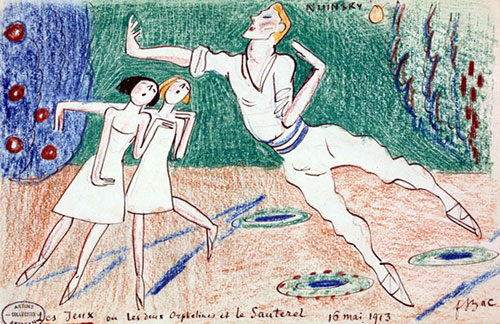
Cartoonist Ferdinand Bac’s (1859 – 1952) Nijinsky captures the great ballet dancer in Debussy’s Jeux; Bac, who said, Nijinsky reminded him of a grasshopper in flight, draws the dancer executing a grand jet├® that spans virtually the entire page. The energy of this work offsets the quietude of Marcel Marceau’s (1923-2007) sketch of himself in the guise of his alter-ego, Bip. The famous mime first turned his hand at drawing when, as a member of the French Resistance, he altered the ID cards of hundreds of Jewish children, helping them to escape the Holocaust, and this drawing conveys with gentle whimsicality the child-like purity of its subject.
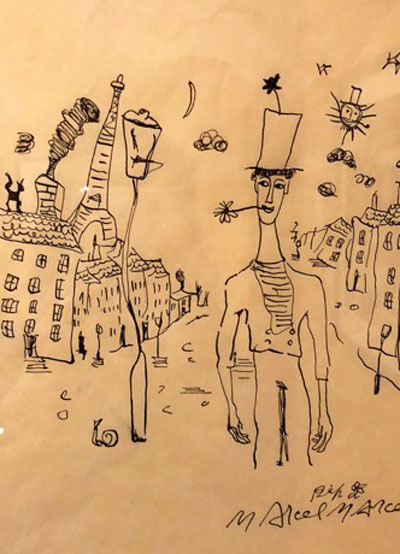
The last work in the exhibition is a self-portrait by Marie Laurencin (1883-1956), the colorful avant garde painter who was a friend of Picasso and Apollinaire. Laurencin wears oversized, mirrored sunglasses and stares cheekily at the viewer, who is, in turn reflected in the mirrors and pulled into the world of the sitter. It is a flashy way to complete the journey which had begun with realistic and subtly psychological works, moved on to abrasive satire and caricature, and ended with fanciful exaggerations that encapsulate the subjects’ personalities more than their physiognomies.
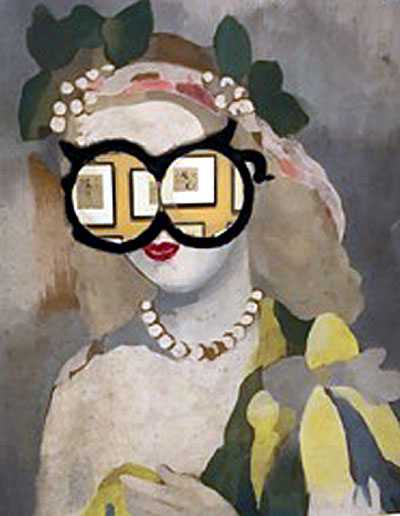
Where Artist’s Hand Meets Author’s Pen offers an unique look at the way words and images complement each other, as well as examining the power of the visual image to intensify the impact of the verbal. In the case of the caricatures, the exhibition reminds the viewer what an incisive and frequently irrational weapon such drawings can be; as in the Dreyfus drawings, the visuals have the power to seer into memory subliminal feelings that only intensify the bigoted agenda of the artist. As Ernst Gombrich observed in 1960, “The secret of a good caricature is that it offers a visual interpretation of a physiognomy which we can then never forget and which the victim will always seem to carry around with him like a man bewitched.”
It is a medium where truth has little place and perception and manufactured reality have all to say. Sound more than a little familiar?
|